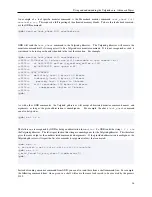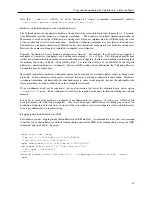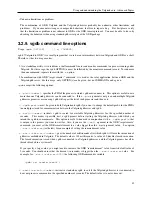
Using and understanding the Valgrind core: Advanced Topics
VALGRIND_STACK_REGISTER(start, end)
:
Registers a new stack. Informs Valgrind that the memory range between start and end is a unique stack. Returns a
stack identifier that can be used with other
VALGRIND_STACK_*
calls.
Valgrind will use this information to determine if a change to the stack pointer is an item pushed onto the stack or a
change over to a new stack. Use this if you’re using a user-level thread package and are noticing spurious errors from
Valgrind about uninitialized memory reads.
Warning:
Unfortunately, this client request is unreliable and best avoided.
VALGRIND_STACK_DEREGISTER(id)
:
Deregisters a previously registered stack. Informs Valgrind that previously registered memory range with stack id
id
is no longer a stack.
Warning:
Unfortunately, this client request is unreliable and best avoided.
VALGRIND_STACK_CHANGE(id, start, end)
:
Changes a previously registered stack.
Informs Valgrind that the previously registered stack with stack id
id
has
changed its start and end values. Use this if your user-level thread package implements stack growth.
Warning:
Unfortunately, this client request is unreliable and best avoided.
3.2. Debugging your program using Valgrind
gdbserver and GDB
A program running under Valgrind is not executed directly by the CPU. Instead it runs on a synthetic CPU provided
by Valgrind. This is why a debugger cannot debug your program when it runs on Valgrind.
This section describes how GDB can interact with the Valgrind gdbserver to provide a fully debuggable program under
Valgrind. Used in this way, GDB also provides an interactive usage of Valgrind core or tool functionalities, including
incremental leak search under Memcheck and on-demand Massif snapshot production.
3.2.1. Quick Start: debugging in 3 steps
The simplest way to get started is to run Valgrind with the flag
--vgdb-error=0
.
Then follow the on-screen
directions, which give you the precise commands needed to start GDB and connect it to your program.
Otherwise, here’s a slightly more verbose overview.
If you want to debug a program with GDB when using the Memcheck tool, start Valgrind like this:
valgrind --vgdb=yes --vgdb-error=0 prog
In another shell, start GDB:
gdb prog
31
Содержание BBV
Страница 176: ...Valgrind FAQ Release 3 8 0 10 August 2012 Copyright 2000 2012 Valgrind Developers Email valgrind valgrind org ...
Страница 177: ...Valgrind FAQ Table of Contents Valgrind Frequently Asked Questions 1 ii ...
Страница 302: ...README mips based on newer GCC versions if possible 95 ...
Страница 303: ...GNU Licenses ...
Страница 304: ...GNU Licenses Table of Contents 1 The GNU General Public License 1 2 The GNU Free Documentation License 8 ii ...
















































